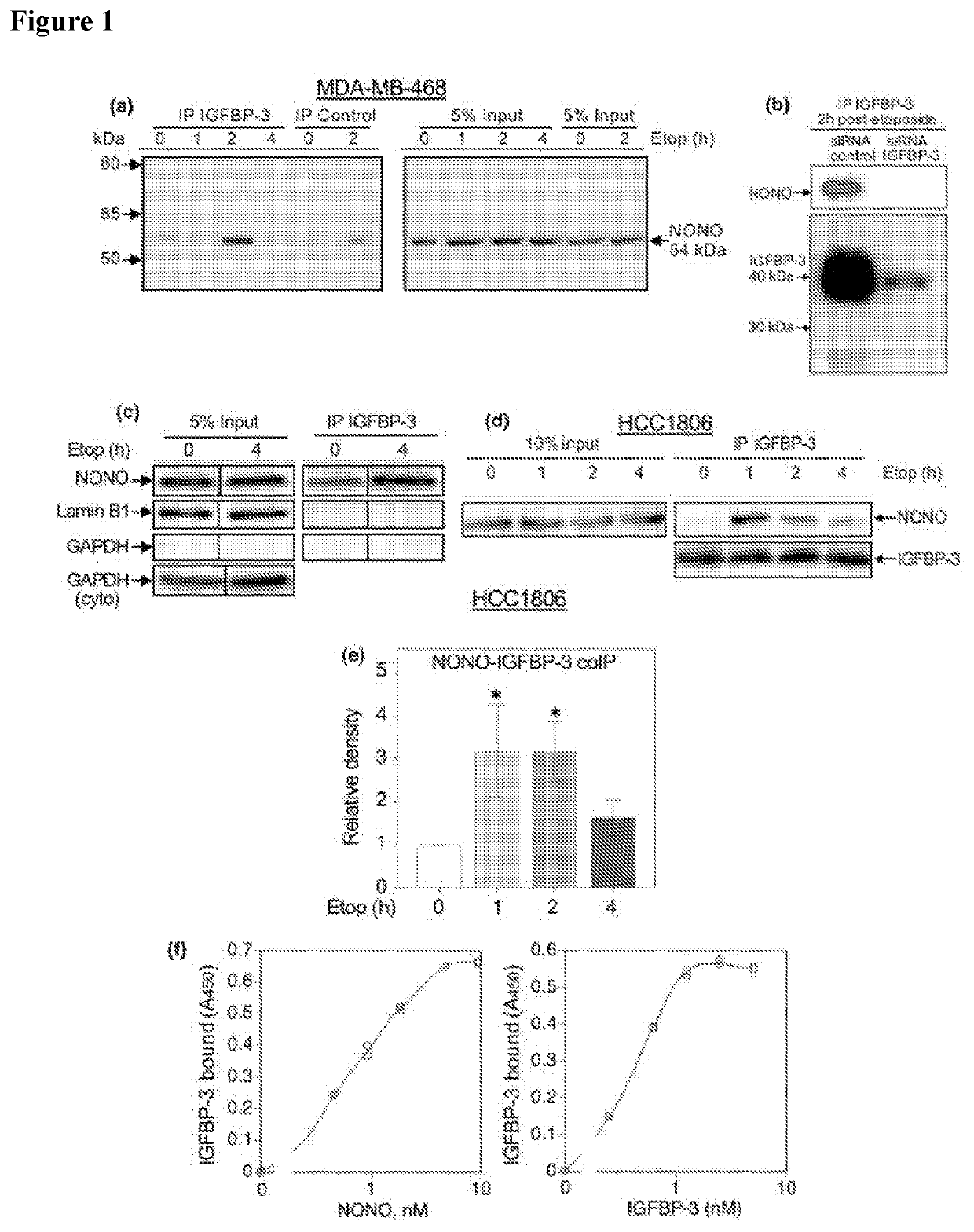Inhibitors and Use Thereof in Cancer Treatment
a cancer and inhibitor technology, applied in the field of inhibitors, can solve the problems of limited treatment progress, unfavorable prognosis, and reduced response of patients, and achieve the effect of reducing the risk of tnbc, and reducing the number of patients
- Summary
- Abstract
- Description
- Claims
- Application Information
AI Technical Summary
Benefits of technology
Problems solved by technology
Method used
Image
Examples
example 1
NONO Interacts with IGFBP-3
[0152]An unbiased proteomic screen for proteins that interact with IGFBP-3 2 h after etoposide treatment was carried out. Examination by LC-MALDI-TOF / TOF mass spectrometry of proteins co-precipitating with IGFBP-3 from whole cell lysates consistently revealed NONO as a putative IGFBP-3 binding partner. Unique peptides for the NONO protein, identified by mass spectrometry from IGFBP-3-coimmunoprecipitation (coIP) experiment are shown in Table 2.
TABLE 2Unique NONO peptides identified by LC-MALDI-TOF / TOF from IGFBP-3co-immunoprecipitation experimentsΔ m / zAccessionRangem / z meas.Mr calc.[ppm]SequenceModificationsNONO_HUMAN143-1531248.60731427.6081−6.49R.FACHSASLTVR.NCarbamidomethyl: 3NONO_HUMAN191-2021231.69201230.672110.25K.GIVEFSGKPAAR.KNONO_HUMAN357-3651263.59891262.5972−4.45R.RQQEEMMRR.QNONO_HUMAN365-3781636.83131635.81187.48R.RQQEGFKGTFPDAR.ENONO_HUMAN366-3781480.72361479.71063.84R.QQEGFKGTFPDAR.ENONO_HUMAN384-3981538.66911537.6622−0.23R.MGQMAMGGAMGINNR.GN...
example 2
The Effects of PARP Inhibition on IGFBP-3 Interaction with NONO
[0156]Since NONO recruitment to DNA damage sites is reported to be PARP-dependent (Krietsch J., Nucl Acids Res., 2012, 40, 10287-10301), we examined the effect of PARP inhibition on the interaction between IGFBP-3 and NONO. FIG. 3a shows in MDA-MB-468 cells that IGFBP-3 complexes with NONO, determined by immunoblotting after coIP, were abolished if cells were preincubated with the PARP1 and PARP2 inhibitor veliparib (20 μM) for 24 h prior to exposure to etoposide. Data for 3 experiments in MDA-MB-468 cells shown in FIG. 3b for IGFBP-3-NONO interactions. A similar inhibitory effect was seen after preincubation with a second PARP inhibitor, olaparib at 10 μM (FIG. 3c). The inhibitory effect of veliparib on complex formation was confirmed by PLA in both MDA-MB-468 and HCC1806 cells (FIG. 3d), showing the increase in IGFBP-3-NONO complexes 2 h after etoposide treatment was abolished by preincubation with 20 μM veliparib. FIG...
example 3
Inhibition of NONO-IGFBP-3 Interaction
[0158]Peptide #66 consistently inhibited IGFBP-3 binding to NONO in the screening assay. This peptide has the sequence HLKFLNVLSPRG (i.e. His-Leu-Lys-Phe-Leu-Asn-Val-Leu-Ser-Pro-Arg-Gly). FIG. 5a shows results from a NONO-IGFBP-3 binding assay comparing peptides #64 to 67 to no added peptide. FIG. 5b shows the mean inhibitory effect of peptide #66 on the NONO-IGFBP-3 interaction from 3 assays, indicated by the lower absorbance value.
PUM
| Property | Measurement | Unit |
|---|---|---|
| resistance | aaaaa | aaaaa |
| length | aaaaa | aaaaa |
Abstract
Description
Claims
Application Information
 Login to View More
Login to View More - R&D
- Intellectual Property
- Life Sciences
- Materials
- Tech Scout
- Unparalleled Data Quality
- Higher Quality Content
- 60% Fewer Hallucinations
Browse by: Latest US Patents, China's latest patents, Technical Efficacy Thesaurus, Application Domain, Technology Topic, Popular Technical Reports.
© 2025 PatSnap. All rights reserved.Legal|Privacy policy|Modern Slavery Act Transparency Statement|Sitemap|About US| Contact US: help@patsnap.com



